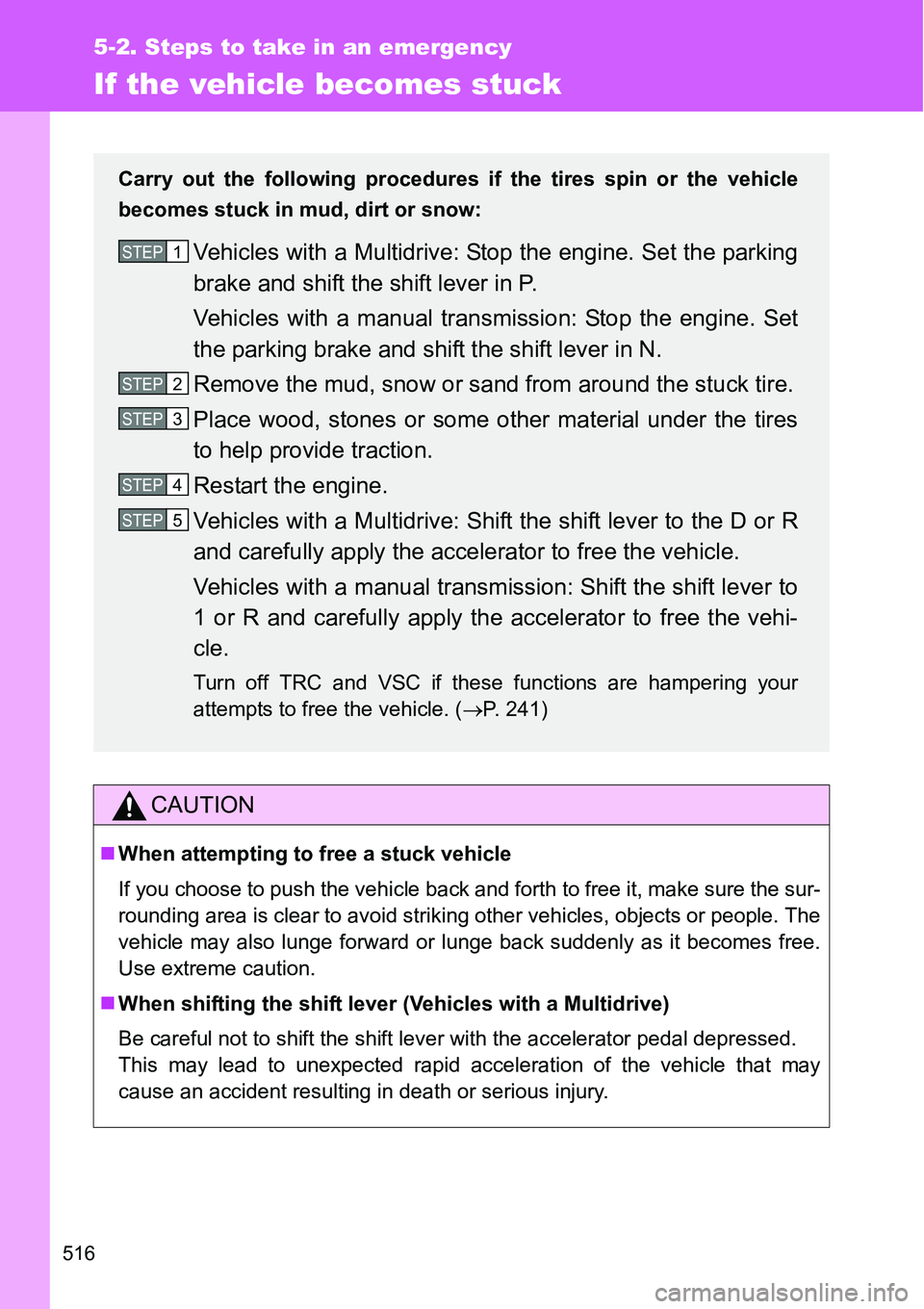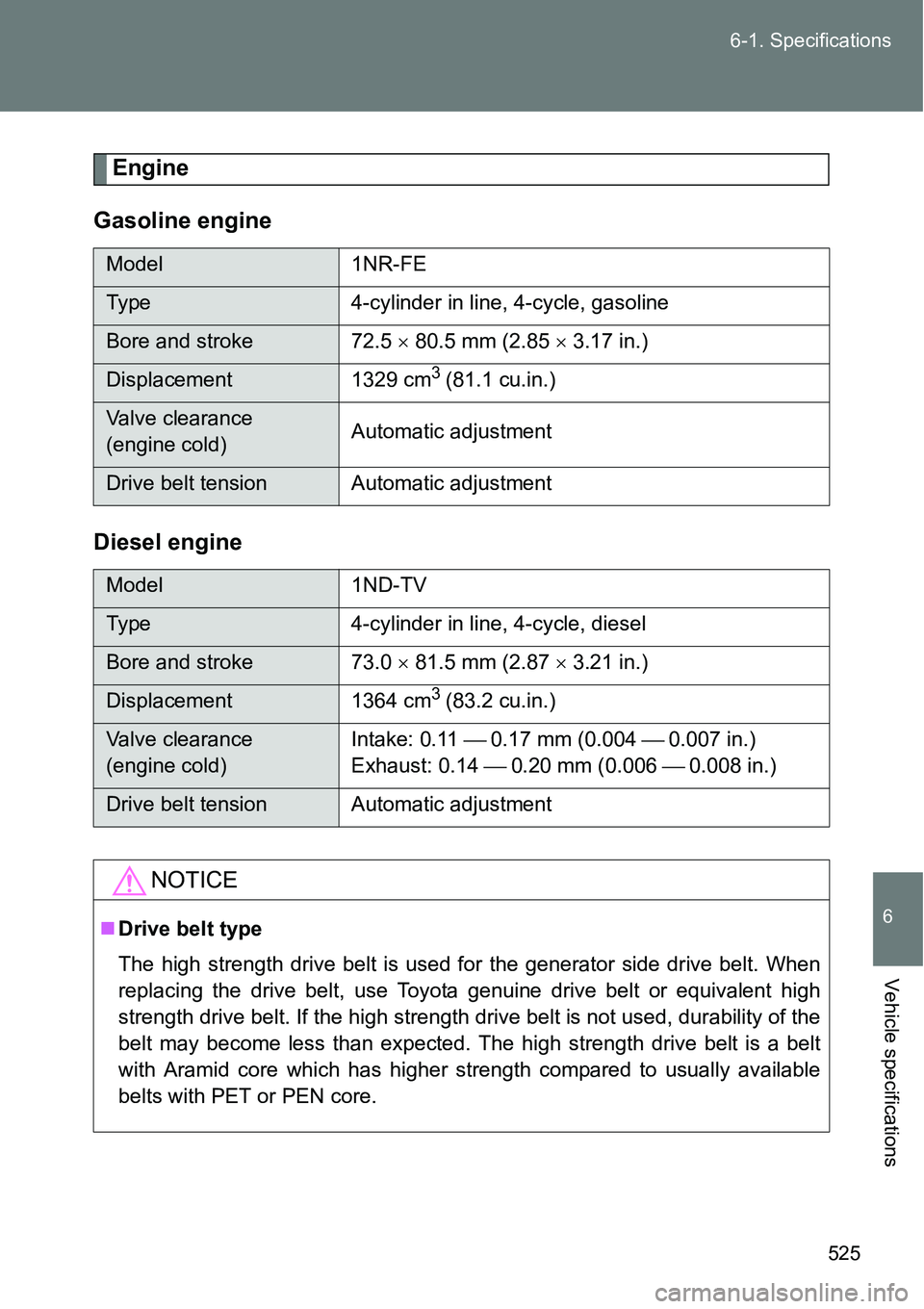Page 515 of 564
5
515 5-2. Steps to take in an emergency
When trouble arises
NOTICE
When restarting the engine
Do not crank the engine before refueling and operating the priming pump.
This may damage the engine and fuel system.
Vehicles without a smart entry & start system: Do not crank for more than
30 seconds at a time. This may overheat the starter and wiring system.
Start the engine. (P. 173, 182)
If the engine does not start after the above steps have been per-
formed, wait for 10 seconds and then try steps 2 and 3 again. If
the engine still does not start, contact any authorized Toyota
dealer or repairer, or another duly qualified and equipped profes-
sional.
After starting the engine, depress the accelerator pedal lightly until
the engine runs smoothly.
STEP5
Page 516 of 564

516
5-2. Steps to take in an emergency
If the vehicle becomes stuck
CAUTION
When attempting to free a stuck vehicle
If you choose to push the vehicle back and forth to free it, make sure the sur-
rounding area is clear to avoid striking other vehicles, objects or people. The
vehicle may also lunge forward or lunge back suddenly as it becomes free.
Use extreme caution.
When shifting the shift lever (Vehicles with a Multidrive)
Be careful not to shift the shift lever with the accelerator pedal depressed.
This may lead to unexpected rapid acceleration of the vehicle that may
cause an accident resulting in death or serious injury.
Carry out the following procedures if the tires spin or the vehicle
becomes stuck in mud, dirt or snow:
Vehicles with a Multidrive: Stop the engine. Set the parking
brake and shift the shift lever in P.
Vehicles with a manual transmission: Stop the engine. Set
the parking brake and shift the shift lever in N.
Remove the mud, snow or sand from around the stuck tire.
Place wood, stones or some other material under the tires
to help provide traction.
Restart the engine.
Vehicles with a Multidrive: Shift the shift lever to the D or R
and carefully apply the accelerator to free the vehicle.
Vehicles with a manual transmission: Shift the shift lever to
1 or R and carefully apply the accelerator to free the vehi-
cle.
Turn off TRC and VSC if these functions are hampering your
attempts to free the vehicle. (P. 241)
STEP1
STEP2
STEP3
STEP4
STEP5
Page 518 of 564
518
5-2. Steps to take in an emergency
If your vehicle has to be stopped in an emergency
Only in an emergency, such as if it becomes impossible to stop the
vehicle in the normal way, stop the vehicle using the following pro-
cedure:
Steadily step on the brake pedal with both feet and firmly
depress it.
Do not pump the brake pedal repeatedly as this will increase the
effort required to slow the vehicle.
Shift the shift lever to N.
If the shift lever is shifted to N
After slowing down, stop the vehicle in a safe place by the
road.
Stop the engine.
If the shift lever cannot be shifted to N
Keep depressing the brake pedal with both feet to reduce
vehicle speed as much as possible.
Vehicles without a smart entry
& start system: Stop the
engine by turning the engine
switch to the “ACC” position.
STEP1
STEP2
STEP3
STEP4
STEP3
STEP4
Page 519 of 564
5
519 5-2. Steps to take in an emergency
When trouble arises
CAUTION
If the engine has to be turned off while driving
Power assist for the brakes and steering wheel will be lost, making the
brake pedal harder to depress and the steering wheel heavier to turn.
Decelerate as much as possible before turning off the engine.
Vehicles without a smart entry & start system: Never attempt to remove
the key, as doing so will lock the steering wheel.
Vehicles with a smart entry &
start system: To stop the
engine, press and hold the
“ENGINE START STOP”
switch for 2 consecutive sec-
onds or more, or press it
briefly 3 times or more in suc-
cession.
Stop the vehicle in a safe place by the road.
Press and hold for 2 seconds or more,
or press briefly 3 times or more
STEP4
STEP5
Page 522 of 564
522
6-1. Specifications
Maintenance data (fuel, oil level, etc.)
Dimensions and weights
Overall length 3990 mm (157.1 in.)
Overall width 1695 mm (66.7 in.)
Overall height*11595 mm (62.8 in.)
Wheelbase 2550 mm (100.4 in.)
TreadFront 1470 mm (57.9 in.)
Rear 1460 mm (57.5 in.)
Gross vehicle
mass
1NR-FE
engineLeft-hand drive vehicles
Manual transmission
1505 kg (3318 lb.)
*2,4
1535 kg (3384 lb.)*2,5
1515 kg (3340 lb.)*3,4
1545 kg (3406 lb.)*3,5
Multidrive
1540 kg (3395 lb.)
*2
1550 kg (3417 lb.)*3
Right-hand drive vehicles
Manual transmission
1515 kg (3340 lb.)
*4
1545 kg (3406 lb.)*5
Multidrive
1550 kg (3417 lb.)
1ND-TV
engine1575 kg (3472 lb.)*4
1600 kg (3527 lb.)*5
Page 524 of 564
524 6-1. Specifications
This number is also on the man-
ufacturer’s label on the left-hand
side center pillar.
Engine number
The engine number is stamped on the engine block as shown.
1NR-FE engine
1ND-TV engine
Page 525 of 564

525 6-1. Specifications
6
Vehicle specifications
Engine
Gasoline engine
Diesel engine
Model 1NR-FE
Type 4-cylinder in line, 4-cycle, gasoline
Bore and stroke 72.5 80.5 mm (2.85 3.17 in.)
Displacement 1329 cm3 (81.1 cu.in.)
Valve clearance
(engine cold)Automatic adjustment
Drive belt tension Automatic adjustment
Model 1ND-TV
Type 4-cylinder in line, 4-cycle, diesel
Bore and stroke 73.0 81.5 mm (2.87 3.21 in.)
Displacement 1364 cm3 (83.2 cu.in.)
Valve clearance
(engine cold)Intake: 0.11 0.17 mm (0.004 0.007 in.)
Exhaust: 0.14 0.20 mm (0.006 0.008 in.)
Drive belt tension Automatic adjustment
NOTICE
Drive belt type
The high strength drive belt is used for the generator side drive belt. When
replacing the drive belt, use Toyota genuine drive belt or equivalent high
strength drive belt. If the high strength drive belt is not used, durability of the
belt may become less than expected. The high strength drive belt is a belt
with Aramid core which has higher strength compared to usually available
belts with PET or PEN core.
Page 526 of 564
526 6-1. Specifications
Fuel
Gasoline engine
Diesel engine
Fuel typeEU area:
Unleaded gasoline conforming to European stan-
dard EN228 only
Except EU area:
Unleaded gasoline only
Research octane num-
ber95 or higher
Fuel tank capacity
(Reference)42 L (11.1 gal., 9.2 Imp. gal.)
Fuel typeEU area:
Diesel fuel conforming to European standard
EN590
Except EU area:
Diesel fuel that contains 50 ppm or less of sulfur
Cetane number 48 or higher
Fuel tank capacity
(Reference)42 L (11.1 gal., 9.2 Imp. gal.)